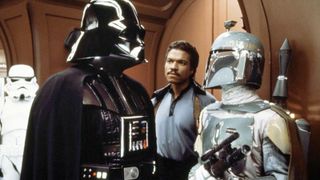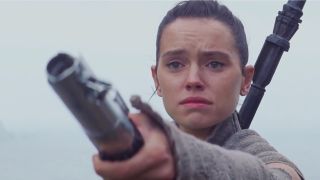Fainting and Lucas going "apeshit" - here's the little-known story behind The Empire Strikes Back
After the mind-blowing success of A New Hope, the pressure was on for the sequel - here's the behind-the-scenes story of how it got made
“When we came over to England [to shoot], we knew there was going to be a Yoda but we didn't know what he would look like,” recalls Kershner. “We talked about using monkeys, then a chimpanzee, then we thought maybe we would use a little kid, then we thought maybe he would be 8-foot tall - huge with a big white beard like Moses.” In the end, Yoda came out a little differently. An aged, squat, solitary Jedi master whose veins pump with wisdom, he’s living on the swamp world of Dagobah when Luke Skywalker turns up to be trained.
Designed by make-up artist Stuart Freeborn, Yoda eventually ended up resembling Freeborn himself. The artist combined his unusual facial features with that of Albert Einstein to give the creature a distinctly intellectual look. In the days before CGI, Yoda was created as a puppet. Muppet man Frank Oz controlled the puppet and afforded him his distinctive voice. But Yoda wasn’t without his complications, as Oz was always below the set, unable to hear the crew (and, pivotally, Hamill) above him.
“Yoda was the most difficult thing to shoot,” Kershner admits. “It was like pulling teeth, but it was exciting! When you saw the rushes, you saw something come alive that had never been done on film - a piece of rubber and plastic, not acting as a puppet, but acting as a living thing. “It was a character that would swallow and breathe and blink. He was incredible! Frank Oz did a great job with his team.” With his unique way of talking and his endearingly oddball manner, Yoda quickly became a favourite character in the Starverse. But there were old favourites returning for Empire as well…

In a saga never lacking in iconic players, two of the first Star Wars’ key figures returned for Empire. Neither Carrie Fisher as Princess Leia or Harrison Ford as cocky maverick Han Solo were contracted to return, and their absence would have seriously dented Empire - if not destroyed it. Luckily, the duo were happy to come back. “The Empire Strikes Back was much more a film about people,” Fisher said in 1982. “It had more of an ambiance than Star Wars. Kershner required that everything in a scene ‘work’ beforehand. While Star Wars was an introduction, Empire really developed the relationships of the main characters.”
For Kershner, working with the famously feisty actress was nothing but a joy. “Carrie was very young and had not done that much work, but she was very, very bright,” the director says. “I possibly didn’t give her the time I should have - I was thinking of so many things - but I didn’t want to mess with her instincts because she seemed to be an intuitive actress. I think it worked - her performance was wonderful.” The director was equally happy to work with Ford. “Harrison had to play a real character with humour, depth, and love for Princess Leia,” he says. “With him, I could make a simple adjustment here and there and he was very, very good.” Despite enjoying working with the pair, it was one of their pivotal scenes that turned out to be Empire’s most trying.
"I know" and the history of Star Wars' best line
That is when Harrison said the line, ‘I know.’” That one line caused a friction between Lucas and Kershner, though. “George went apeshit.”
Harrison Ford
Ask Kershner which scene from Empire Strikes Back was the hardest to get right, and he doesn’t even have to pause to answer. “The toughest shoot was the Carbon Freeze scene,” he says, referring to the infamous moment when Han Solo is sent to his doom, frozen in a carbon coffin by the villainous Darth Vader. “The set was painted black,” Kershner recalls. “It was a round set but we couldn’t build the full circle because it would have been very hard to manipulate with the camera. So we built half of it, and it was a challenge because it was very hot and we were using lots of steam shooting out of the floor. “Some of the little people fainted because they were closer to the steam. The staging was very difficult. The actors were about 30 feet off the ground and we had to be careful that they didn’t fall.” That particular scene also became a bone of contention between Kershner and Lucas.

You all know the moment. “There was a moment,” Ford recalled recently, “when Han Solo was about to be frozen into carbonite, and finally the princess reveals her great love for him. And her line is, ‘I love you.’ “And George [Lucas] had artfully contrived for Han Solo to say, ‘I love you too.’ I thought it was a lost opportunity. This character never behaved so unabashedly, and I thought, are we pissing away this great opportunity for the character?” Instead, Ford and Kershner attempted to find a way around Solo’s sudden confession of love. But reshooting the line in different ways still didn’t seem to work.
Sign up to the GamesRadar+ Newsletter
Weekly digests, tales from the communities you love, and more
“We were into the lunch break,” says Kershner, “and I said to Harrison try it again and just do whatever comes to mind. That is when Harrison said the line, ‘I know.’” That one line caused a friction between Lucas and Kershner, though. “George went apeshit,” Ford remembers. “He thought it was horrible, and that we’d get a bad laugh.” Adds Kershner: “George saw the first cut and felt that the audience would laugh. We agreed that we would do two preview screenings once the film was cut with the line in, and then with the line out. “At the first preview in San Francisco, the house broke up after Han Solo said ‘I know’. When the film was over, people came up and said that is the most wonderful line and it worked. So George decided not to have the second screening.”
There was no bad blood between the director and his producer, though. “George was the best producer I ever worked with,” Kershner recognises. “He left me alone and only came to England a few times. “I told George at one point that I was behind schedule. His answer was, 'Keep doing what you are doing. Just keep shooting.' This was the greatest thing for a director to hear from a producer.” Kershner, though, wouldn’t return for Episode 6...
No Return For Jedi
When The Empire Strikes Back opened 21 May 1980, newly afforded an episode number, it grossed a healthy $10m in its opening weekend. Quickly, the film recouped the $33m that Lucas had squeezed out of the banks. Ever the nice guy, Lucas handed out bonuses to the amount of $5m to his employees. Prepping on Lucas’ third and final Star Wars movie (for then) would quickly jump into pre-production. Though Hamill, Ford and Fisher would all return, director Irvin Kershner wouldn’t. “After working for two years and nine months doing Empire,” he said, “and having it take so much out of my life and having given me so much, I felt that it was a complete experience and it was time to move on.”
He perhaps felt he had a dodged a bullet. After seeing Return of the Jedi, Kershner was quoted as saying: “It didn't quite work for me. It was a nice picture but I expected something different. I thought it would be a different kind of film. It had fabulous stuff in it but it didn't work for me.” He’s eased up on the trilogy-capper since, saying in a recent interview: “It has been so long since I saw the film, I can’t really comment on what I didn’t like about it. I know it was not an easy film to make, and the special effects - as with Empire - are remarkable to me, given that it was not done with CGI.”

The director certainly hadn’t gone off the Starverse, either. Asked by an interviewer 10 years after directing Empire if he’d like to take on one of the Star Wars prequels, he replied with an enthusiastic “absolutely!” “I would definitely do it,” he said in that pre-Phantom Menace era. “That's the only one that I would do again because I don't want to do anymore sequels. I've done enough. But those won't be sequels - it's really like a whole new series of films. And I know that if George does anything, he'll do it well. I would be honoured to do another one.” Ah, what could have been…
Read page 3 to learn why Lucas' insisted on creating the CGI-heavy special editions and the enduring legacy of Empire Strikes back…
Josh Winning has worn a lot of hats over the years. Contributing Editor at Total Film, writer for SFX, and senior film writer at the Radio Times. Josh has also penned a novel about mysteries and monsters, is the co-host of a movie podcast, and has a library of pretty phenomenal stories from visiting some of the biggest TV and film sets in the world. He would also like you to know that he "lives for cat videos..." Don't we all, Josh. Don't we all.
Most Popular




